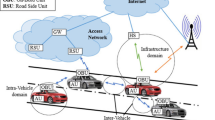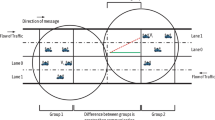Abstract
Vehicular ad-hoc network (VANET) is becoming a promising technology for improving the efficiency and the safety of intelligent transportation systems by deploying a wide variety of applications. Smart vehicles are expected to continuously exchange a huge amount of data either through safety or non-safety messages dedicated for road safety or infotainment and passenger comfort applications, respectively. One of the main challenges posed by the study of VANET is the data dissemination design by which messages have to be efficiently disseminated in a high vehicular speed, intermittent connectivity, and highly dynamic topology. In particular, broadcast mechanism should guarantee fast and reliable data delivery within a limited wireless bandwidth in order to fit the real time applications’ requirements. In this work, we propose a simple and efficient adaptive data dissemination protocol called “SEAD”. On the one hand, the originality of this work lies in its simplicity and efficiency regardless the application’s type. Simplicity is achieved through a beaconless strategy adopted to take into account the surrounding vehicles’ density. Thanks to a metric locally measured, each vehicle is able to dynamically define an appropriate probability of rebroadcast to mitigate the broadcast storm problem. Efficiency is manifested by reducing excessive retransmitted messages and hence promoting the network capacity and the transmission delay. The simulation results show that the proposed protocol offers very low packet drop ratio and network load while still maintaining a low end-to-end delay and a high packet delivery. On the other hand, SEAD protocol presents a robust data dissemination mechanism which is suitable either for safety applications or for other kinds of application. This mechanism is able to adapt the protocol performance in terms of packet delivery ratio to the application’s requirements.













Similar content being viewed by others
References
Achour, I., Bejaoui, T., & Tabbane, S. (2014). Network coding approach for vehicle-to-vehicle communication: Principles, protocols and benefits. In: Software, Telecommunications and Computer Networks (SoftCOM), 2014 22nd International Conference on, IEEE, pp. 154–159.
Ahlswede, R., Cai, N., Li, S. Y., & Yeung, R. W. (2000). Network information flow. IEEE Transactions on Information Theory, 46(4), 1204–1216.
Bhuiyan, M. M., Salim, S. M., & Hasan, M. R. (2011). Density aware broadcasting scheme for vanet. In: Communications (APCC), 2011 17th Asia-Pacific Conference on, IEEE, pp. 467–471.
Blum, J. J., & Eskandarian, A. (2009). Avoiding timeslot boundary synchronization for multihop message broadcast in vehicular networks. In: Vehicular Technology Conference, 2009. VTC Spring 2009. IEEE 69th, IEEE, pp. 1–5.
Chaqfeh, M., Lakas, A., & Jawhar, I. (2014). A survey on data dissemination in vehicular ad hoc networks. Vehicular Communications, 1(4), 214–225.
Dong-Won, K., Ajmal, K., & You-Ze, C. (2012). Traffic density-based broadcast scheme for vehicular ad hoc networks. IEICE Transactions on Communications, 95(12), 3875–3878.
ETSI E. (2014). 637-3 ITS. Vehicular communications; Basic set of applications; Part 2: Specification of decentralized environmental notification basic service.
ETSI T. (2009). Intelligent transport systems (ITS); Vehicular communications; Basic set of applications; definitions. Technical Report, ETSI TR 102 638.
Group IW, et al. (2010). Ieee standard for information technology-telecommunications and information exchange between systems-local and metropolitan area networks-specific requirements—Part 11: Wireless lan medium access control (MAC) and physical layer (PHY) specifications amendment 6: Wireless access in vehicular environments. IEEE Std 802:11p.
Kumar, R., Dave, M., et al. (2012). A review of various vanet data dissemination protocols. International Journal of U-and E-Service, Science and Technology (IJUNESST), 5(3), 27–44.
Li, P., Guo, S., Yu, S., & Vasilakos, A. V. (2012). Codepipe: An opportunistic feeding and routing protocol for reliable multicast with pipelined network coding. In: INFOCOM, 2012 Proceedings IEEE, IEEE, pp. 100–108.
Li, P., Guo, S., Yu, S., & Vasilakos, A. V. (2014). Reliable multicast with pipelined network coding using opportunistic feeding and routing. IEEE Transactions on Parallel and Distributed Systems, 25(12), 3264–3273.
Lipman, J., Liu, H., & Stojmenovic, I. (2009). Broadcast in ad hoc networks. In: Guide to wireless ad hoc networks (pp. 121–150). Berlin: Springer.
Liu, J., Wan, J., Wang, Q., Deng, P., Zhou, K., & Qiao, Y. (2015). A survey on position-based routing for vehicular ad hoc networks. Telecommunication Systems. doi:10.1007/s11235-015-9979-7.
Liu, J., Wan, J., Wang, Q., Li, D., Qiao, Y., & Cai, H. (2015). A novel energy-saving one-sided synchronous two-way ranging algorithm for vehicular positioning. Mobile Networks and Applications. doi:10.1007/s11036-015-0604-5.
Liu, L., Song, Y., Zhang, H., Ma, H., & Vasilakos, A. V. (2015). Physarum optimization: A biology-inspired algorithm for the steiner tree problem in networks. IEEE Transactions on Computers, 64(3), 819–832.
Liu, Y., Xiong, N., Zhao, Y., Vasilakos, A. V., Gao, J., & Jia, Y. (2010). Multi-layer clustering routing algorithm for wireless vehicular sensor networks. IET Communications, 4(7), 810–816.
Marwaha, S., Srinivasan, D., Tham, CK., & Vasilakos, A.: (2004). Evolutionary fuzzy multi-objective routing for wireless mobile ad hoc networks. In: Evolutionary Computation, 2004. CEC2004. Congress on (Vol. 2, pp. 1964–1971), IEEE.
Meng, T., Wu, F., Yang, Z., Chen, G., & Vasilakos, A. (2015). Spatial reusability-aware routing in multi-hop wireless networks. IEEE Transactions on Computers PP, 1, 1–1.
NS3. (2014). NS-3—Network simulator project. https://www.nsnam.org/. Accessed January 30, 2014.
Panichpapiboon, S., & Pattara-Atikom, W. (2012). A review of information dissemination protocols for vehicular ad hoc networks. Communications Surveys & Tutorials, IEEE, 14(3), 784–798.
Rahimi, M. R., Venkatasubramanian, N., Mehrotra, S., & Vasilakos, A. V. (2012). Mapcloud: Mobile applications on an elastic and scalable 2-tier cloud architecture. In: Proceedings of the 2012 IEEE/ACM Fifth International Conference on Utility and Cloud Computing (pp. 83–90), IEEE Computer Society.
Schwartz, R. S., Barbosa, R. R., Meratnia, N., Heijenk, G., & Scholten, H. (2011). A directional data dissemination protocol for vehicular environments. Computer Communications, 34(17), 2057–2071.
Schwartz, R. S., Das, K., Scholten, H., & Havinga, P. (2012). Exploiting beacons for scalable broadcast data dissemination in vanets. In: Proceedings of the ninth ACM international workshop on Vehicular inter-networking, systems, and applications (pp. 53–62), ACM.
Schwartz, R. S., Scholten, H., & Havinga, P. (2013). A scalable data dissemination protocol for both highway and urban vehicular environments. EURASIP Journal on Wireless Communications and Networking, 1, 1–19.
Spyropoulos, T., Rais, R. N., Turletti, T., Obraczka, K., & Vasilakos, A. (2010). Routing for disruption tolerant networks: taxonomy and design. Wireless networks, 16(8), 2349–2370.
SUMO. (2013). SUMO—Simulation of urban mobility. http://sumo.sourceforge.net/. Accessed March 30, 2013.
Tseng, Y. C., Ni, S. Y., Chen, Y. S., & Sheu, J. P. (2002). The broadcast storm problem in a mobile ad hoc network. Wireless networks, 8(2–3), 153–167.
Tseng, Y. T., Jan, R. H., Chen, C., Wang, C. F. & Li, H. H. (2010) A vehicle-density-based forwarding scheme for emergency message broadcasts in vanets. In: Mobile Adhoc and Sensor Systems (MASS), 2010 IEEE 7th International Conference on (pp. 703–708), IEEE.
Vasilakos, A. V., Zhang, Y., & Spyropoulos, T. (2011). Delay tolerant networks: Protocols and applications. Boca Raton: CRC Press.
Wisitpongphan, N., Tonguz, O. K., Parikh, J. S., Mudalige, P., Bai, F., & Sadekar, V. (2007). Broadcast storm mitigation techniques in vehicular ad hoc networks. Wireless Communications, IEEE, 14(6), 84–94.
Yen, Y. S., Chao, H. C., Chang, R. S., & Vasilakos, A. (2011). Flooding-limited and multi-constrained qos multicast routing based on the genetic algorithm for manets. Mathematical and Computer Modelling, 53(11), 2238–2250.
Yeung, R. W. (2011). Network coding: A historical perspective. Proceedings of the IEEE, 99(3), 366–371.
Zeng, Y., Xiang, K., Li, D., & Vasilakos, A. V. (2013). Directional routing and scheduling for green vehicular delay tolerant networks. Wireless networks, 19(2), 161–173.
Zhou, L., Xiong, N., Shu, L., Yeo, S. S., et al. (2010). Context-aware middleware for multimedia services in heterogeneous networks. IEEE Intelligent Systems, 25(2), 40–47.
Acknowledgments
This work is a part of the MOBIDOC project achieved under the PASRI program, funded by the European Union and administrated by the ANPR.
Author information
Authors and Affiliations
Corresponding author
Rights and permissions
About this article
Cite this article
Achour, I., Bejaoui, T., Busson, A. et al. SEAD: A simple and efficient adaptive data dissemination protocol in vehicular ad-hoc networks. Wireless Netw 22, 1673–1683 (2016). https://doi.org/10.1007/s11276-015-1050-9
Published:
Issue Date:
DOI: https://doi.org/10.1007/s11276-015-1050-9




